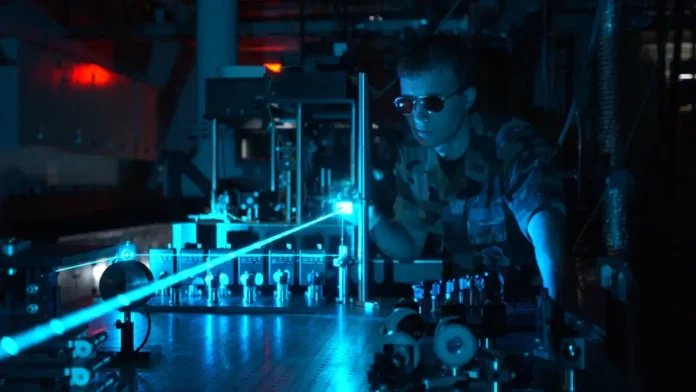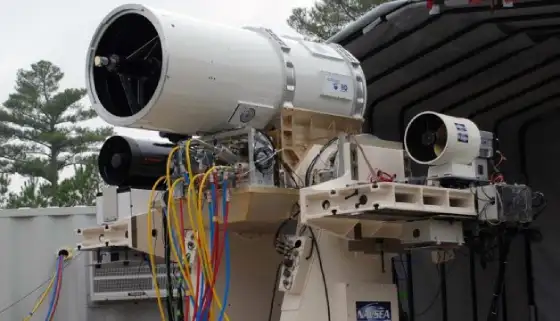
In the ever-evolving landscape of military technology, Directed Energy Weapons (DEWs) are an emerging new technology. This technology was once thought to be science fiction but now it is becoming true with the help of cutting-edge research and development. These weapons harness the power of focused energy, including lasers, microwaves, and particle beams, to deliver precise and efficient destruction to targets. In this article, we will learn what directed energy weapons are and also learn the primary types of DEWs, challenges, and the transformative potential they hold for the future of warfare and defense.
Contents
What are Directed Energy Weapons?
Directed Energy Weapons (DEWs) are a class of futuristic weapons that utilize focused energy, such as lasers, microwaves, or particle beams, to deliver precise and efficient destructive force to targets. Unlike traditional weapons that rely on projectiles like bullets or missiles, DEWs operate by emitting concentrated beams of energy.
Directed Energy Weapons represent a leap forward in military technology, offering the potential for more precise, rapid, and versatile engagement on the battlefield. This technology is still in the developmental stage however when fully developed it could reshape the future of warfare and defense strategies, provided that technical challenges are successfully addressed.
Many countries also conducting research and development of Directed Energy Weapons (DEWs), a field marked by its sensitivity and often classified nature. In the United States, ongoing programs involve the development of High-Energy Laser systems for applications such as missile defense and anti-drone capabilities, along with Solid-State Laser systems for various military uses. Russia is also conducting tests on DEW prototypes, although specific system names are not always publicly disclosed.
China, on the other hand, has shown interest in High-Power Microwave (HPM) systems for electronic warfare and laser systems designed for anti-satellite and missile defense purposes. In Israel, there’s a focus on Tactical High-Energy Laser (HEL) systems for air defense and missile defense using laser technologies. With the help of DRDO India also conducting research and development of laser weapons for air defense and anti-satellite applications, along with research into Electromagnetic Railgun technology.
The primary types of DEWs are as follows:
Laser Weapons
Laser weapons generate intense beams of light, often in the form of concentrated photons. These beams are directed towards a target, where the energy is absorbed, leading to heating and damage. Laser weapons offer speed-of-light engagement, meaning they travel at the speed of light, providing rapid and precise targeting. These weapons are being developed for diverse applications, including missile defense, anti-aircraft systems, and even anti-satellite operations.
At the heart of directed energy weapons lies the ingenuity of laser technology. Laser weapons, with their concentrated beams of light, are at the forefront of this revolutionary arsenal. Unlike traditional projectiles, lasers travel at the speed of light, offering unparalleled speed and precision.
Characteristics of Laser Weapons
- Speed of Light: The defining characteristic of laser weapons is their ability to engage targets at the speed of light. This instantaneous response provides a critical advantage in scenarios where split-second decisions can determine success or failure.
- Precision Targeting: One of the key advantages of directed energy weapons, particularly lasers, is their precision. The focused nature of laser beams allows for accurate targeting with minimal collateral damage. This precision is invaluable in situations where distinguishing between friend and foe country is crucial, making DEWs a potential game-changer in minimizing unintended consequences of military operations.
Microwave Weapons
Microwave weapons emit focused microwaves, which can interfere with or damage electronic systems. They are particularly effective against the electronic components of enemy vehicles and communication systems. Microwave weapons are employed for electronic warfare, disrupting or damaging enemy electronic systems. They also have non-lethal applications, such as crowd control, where focused beams cause discomfort without causing permanent harm.
In the arsenal of directed energy weapons, microwaves play a unique role in disrupting and damaging electronic systems. These weapons operate by emitting focused microwaves, capable of interfering with or damaging the electronic components of enemy vehicles, communication systems, and other vital infrastructure.
Characteristics of Microwave weapons
- Electronic Warfare: Microwave weapons, as a form of electronic warfare, target the vulnerabilities of modern technology. By disrupting or damaging electronic systems, they can disable enemy vehicles, neutralize communication networks, and create strategic advantages on the battlefield. This capability makes microwaves a potent tool for controlling and dominating the electromagnetic spectrum.
- Non-Lethal Applications: Beyond their destructive potential, microwaves also find applications in non-lethal uses. Microwave-based systems can be employed for crowd control by emitting focused beams that cause discomfort without causing permanent harm. This dual-use nature adds a layer of versatility to directed energy weapons, expanding their utility in various scenarios.
Particle Beam Weapons
Particle beam weapons accelerate charged or neutral particles (ions, electrons, or neutral particles) to high velocities and direct them to a target. The kinetic energy from these high-speed particles causes damage to the target. Particle beams come in various forms, allowing for versatility in military applications. They can be used for anti-missile defense, anti-satellite operations, and other scenarios where precision and adaptability are crucial.
Particle beam weapons represent another facet of directed energy weaponry, utilizing accelerated charged or neutral particles to deliver kinetic energy to targets. The science behind particle beams opens up new possibilities for futuristic warfare scenarios.
Characteristics of Particle Beam Weapons
- Ion, Electron, and Neutral Particle Beams: Particle beams can take various forms, including ion beams, electron beams, and neutral particle beams. Each type has unique characteristics, influencing their applications and effectiveness in different scenarios. Choosing the appropriate particle type for a given mission adds a layer of flexibility to deploying directed energy weapons.
- High-Velocity Precision: The high velocities achieved by accelerated particles result in a formidable kinetic impact on targets. This precision, combined with the adaptability of particle beams, makes them suitable for a range of military applications, from anti-missile defense to anti-satellite operations.
Transformative Potential of DEWs
The transformative potential that Directed Energy Weapons (DEWs) hold for the future of warfare and defense is both profound and far-reaching. As these advanced technologies continue to evolve, they promise to reshape the very nature of military strategy and the dynamics of global security. Here are some key aspects of the transformative potential of DEWs:
- Precision and Efficiency: DEWs offer a level of precision unparalleled in traditional weaponry. The ability to deliver focused energy with pinpoint accuracy allows for targeted engagement, minimizing collateral damage and reducing the risk to civilians and critical infrastructure.
- Speed-of-Light Engagement or Rapid Response: The speed-of-light engagement characteristic of DEWs provides military forces with a rapid response capability. This instantaneous reaction time can prove decisive in critical situations, offering a strategic advantage in scenarios where timing is of the essence.
- Versatility in Applications or Adaptability: DEWs demonstrate remarkable versatility in their applications. From missile defense and anti-aircraft systems to non-lethal crowd control, these weapons can be adapted to a wide range of military and security scenarios, enhancing the flexibility and effectiveness of defense strategies.
- Reduced Logistics and Costs: DEWs, particularly laser weapons, have the potential to reduce logistical challenges associated with traditional munitions. The need for vast stockpiles of physical ammunition could be mitigated, leading to more streamlined and cost-effective military operations.
- Technological Innovation and Research and Development: The pursuit of DEWs encourages ongoing technological innovation. Governments and defense industries invest in cutting-edge research and development to overcome technical challenges, driving advancements not only in directed energy technologies but also in related fields.
- Shift in Military Dynamics: The integration of DEWs into military arsenals could usher in new strategic paradigms. Nations possessing advanced directed energy capabilities may have a unique edge in conflicts, potentially altering the traditional balance of power on the global stage.
- Human-Machine Collaboration: The development of DEWs involves the integration of autonomous systems. This marks a shift toward human-machine collaboration, where advanced technologies assist military personnel in decision-making processes, intelligence gathering, and strategic planning.
- Deterrence and Defense or Strategic Deterrence: DEWs can serve as a deterrent, dissuading potential adversaries from engaging in aggressive actions. The prospect of facing highly precise and rapid-response-directed energy systems may influence the strategic calculus of nations.
- Environmental Considerations: Compared to traditional munitions that may have significant environmental consequences, DEWs have the potential to offer reduced environmental impact. This consideration aligns with broader global efforts toward more sustainable and responsible military practices.
While the transformative potential of DEWs holds great promise, it is crucial to approach their development and deployment with ethical vigilance and a commitment to international norms. Striking a balance between harnessing technological advancements for enhanced security and addressing the associated ethical concerns will be essential in realizing a future where Directed Energy Weapons contribute positively to global defense strategies.
Technical Challenges and Limitations
While the promise of directed energy weapons is tantalizing, the road to their widespread adoption is not without hurdles. Several technical challenges and limitations must be overcome to fully unlock their potential.
- Power Generation and Management: One of the primary challenges lies in the efficient generation and management of the immense power required for directed energy weapons. Sustaining a continuous and powerful beam, especially in dynamic battlefield conditions, demands advanced power systems and efficient energy management solutions.
- Beam Control and Atmospheric Interference: Controlling the trajectory of directed energy beams is crucial for accurate targeting. Factors such as atmospheric interference, including clouds and turbulence, can affect the path of the beams. Overcoming these challenges requires sophisticated beam control systems capable of adapting to changing environmental conditions.
Ethical Concerns
The development and deployment of Directed Energy Weapons (DEWs) raise various ethical concerns that span from their potential impact on warfare to broader societal implications. Below are some key ethical considerations associated with DEWs:
- Humanitarian Concerns: While DEWs are designed to be precise, any weapon system has the potential for unintended consequences. Ensuring that DEWs do not cause unnecessary harm to civilians or infrastructure is crucial to upholding humanitarian principles.
- Escalation of Conflict: The increased efficiency and precision of DEWs may lower the threshold for the use of force, potentially leading to an escalation of conflicts. Nations might be more inclined to use these weapons if they believe they can control and limit the impact, potentially leading to more frequent and intense military engagements.
- Security and Proliferation: Concerns arise regarding the illicit acquisition and use of DEWs by non-state actors or rogue nations. The potential for these weapons to fall into the wrong hands could have severe consequences, as they may be used for terrorist attacks or other malicious purposes.
- Legal and Regulatory Frameworks: DEWs pose challenges to existing international laws governing armed conflict. Questions about the legality of certain uses of DEWs and the adequacy of current legal frameworks in addressing these technologies need careful consideration.
- Autonomous Systems and Ethics: Some DEW systems may incorporate autonomous targeting capabilities. The ethical implications of allowing machines to make life-and-death decisions, even in the context of warfare, raise concerns about accountability, transparency, and adherence to ethical standards.
- Long-Term Health and Environmental Effects: The long-term health and environmental effects of DEWs are not yet fully understood. The release of intense energy in various forms could have unforeseen consequences on the environment and human health, necessitating careful evaluation and risk assessment.
- Global Power Dynamics: The possession and deployment of advanced DEWs by certain nations may contribute to an imbalance of power on the global stage. This could have geopolitical repercussions and impact diplomatic relations.
- Economic and Social Disparities: The development and deployment of DEWs require significant financial resources. This raises concerns about the potential for increased global inequality, as only certain nations or entities may have the means to access and utilize these advanced technologies.
Conclusion
As we peer into the future of warfare, directed energy weapons stand as a testament to humanity’s quest for innovation and mastery over the forces of nature but at the same time raise ethical concerns. The brilliance of laser weapons, the disruptive power of microwaves, and the kinetic precision of particle beams collectively redefine the possibilities of military strategy. While technical challenges remain, the potential benefits, including reduced collateral damage and rapid response capabilities, underscore the transformative impact directed energy weapons could have on the future battlefield. As research and development efforts continue, we find ourselves on the brink of a new era, where the power of light becomes a formidable force in the arsenal of nations.
However, as we discussed earlier it raises ethical concerns which requires a multidisciplinary approach involving policymakers, ethicists, scientists, and the broader public. Transparent and inclusive discussions about the development, deployment, and regulation of DEWs are essential to ensure that these technologies align with ethical principles, international norms, and the broader interests of humanity. As DEW technology continues to evolve, ongoing ethical scrutiny and responsible decision-making will be vital in shaping their future use.
Also Read: Operation Whitewash: Laser Beam Experiment or a Conspiracy Theory
Sources
- Zohuri, Bahman, and Bahman Zohuri. Directed energy weapons. Springer International Publishing, 2016.
- Weise, Th HGG, et al. “Overview of directed energy weapon developments.” 2004 12th Symposium on Electromagnetic Launch Technology. IEEE, 2004.
- Here is the MLA citation for the provided website link:
- “Indian Navy Signs Contract with BEL for Supply of Naval Anti-Drone System.” Terminal Defence Research & Development Establishment (TDF DRDO), 2023.
- Lavan, Michael J., and John J. Wachs. “US Army high energy laser (HEL) technology program.” Technologies for Optical Countermeasures VIII. Vol. 8187. SPIE, 2011.
- Cook, Joung. “High-energy laser weapons since the early 1960s.” Optical Engineering 52.2 (2013): 021007-021007.
- Shen, Zeyi, Wei Xin, and Yang Song. “Progress of research on high energy laser component.” Fourth International Symposium on High Power Laser Science and Engineering (HPLSE 2021). Vol. 11849. SPIE, 2021.
- Shwartz, Josef, Gerald T. Wilson, and Joel M. Avidor. “Tactical high-energy laser.” Laser and Beam Control Technologies. Vol. 4632. SPIE, 2002.
- Gunzinger, Mark, and Chris Dougherty. Changing the game: The promise of directed-energy weapons. Center for Strategic and Budgetary Assessments, 2012.
- Bloembergen, Nicolaas, et al. “Report to the American Physical Society of the study group on science and technology of directed energy weapons.” Reviews of Modern Physics 59.3 (1987): S1.
- Obering, Henry” Trey. “Directed energy weapons are real… and disruptive.” Prism 8.3 (2019): 36-47.
- Geis, John P. Directed Energy Weapons on the Battlefield: A new vision for 2025. No. 32. Center for Strategy and Technology, Air War College, Air University, 2003.
- Horkovich, James. “Directed Energy Weapons: Promise & Reality.” 37th AIAA Plasmadynamics and Lasers Conference. 2006.
- Kochems, Alane, and Andrew Gudgel. “The Viability of Directed-Energy Weapons.” The Heritage Foundation Online 1931 (2006): 1.
- Patel, C. Kumar N., and Nicolaas Bloembergen. “Strategic defense and directed-energy weapons.” Scientific American 257.3 (1987): 39-45.
- Nielsen, Philip E. Effects of directed energy weapons. NDU Press, 1994.
FACT CHECK: We strive for accuracy and fairness. But if you see something that doesn’t look right, please Contact us.
DISCLOSURE: This Article may contain affiliate links and Sponsored ads, to know more please read our Privacy Policy.
Stay Updated: Follow our WhatsApp Channel and Telegram Channel.













